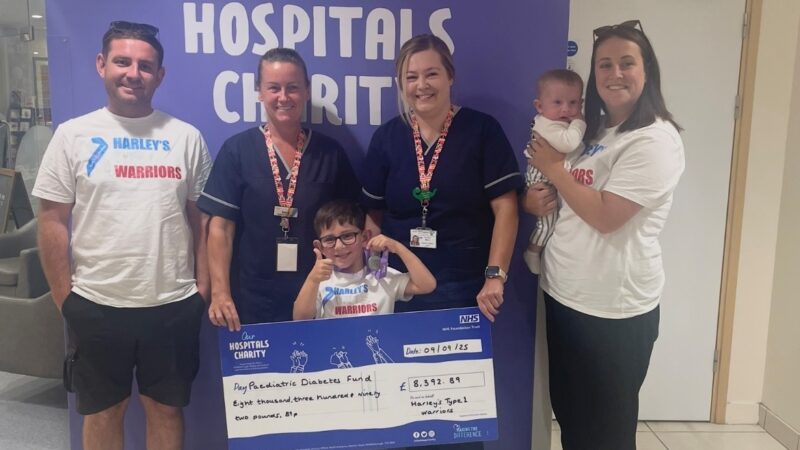
After noticing some classic signs of type 1 diabetes, known as the four Ts – thinner, toileting more, thirst and tiredness, Harley’s parents Emily and Adam Muscroft took him to the GP.
“We were rushed straight to hospital and admitted for a couple of weeks,” recalls Emily.
“As a family we knew very little about this autoimmune disease before Harley was diagnosed and we were so lucky to get Harley treated when we did to prevent him going into DKA (diabetic ketoacidosis).”
Learning a new way of life
During his hospital stay, the diabetes team worked closely with Emily and Adam and supported them to learn a whole new way of life, including carb counting, giving insulin and using pumps and sensors to keep Harley safe.
Shortly after his discharge, Harley started visiting the hospital’s diabetes clinic.
Emily added: “There is no doubt in our minds that the GP surgery, diabetes team and the children’s unit saved our little boy’s life.
It is because of them that Harley got to meet his little brother and start in year 1 at school.”
Helping others
Grateful for the care he receives, Harley decided he wanted to give something back and raise some money to help others.
Together with his family, he organised a sponsored walk from Whitby to Sandsend, one of his favourite places.
Over 140 people, including Harley’s family and friends, joined the beach walk and local businesses provided t-shirts and refreshments, helping to make the event a huge success.
“Harley wanted to raise money to help other children who are diagnosed with type 1 diabetes,” said his dad, Adam.
“We also wanted to raise awareness of this disease, which has helped some other families to have their children tested and diagnosed.”

Despite living with the daily challenges of type 1 diabetes, Harley continues to take it all in his stride.
“He always has a smile on his face, even on the hard days or sleepless nights, when the blood glucose alarms go off constantly,” Emily added.
“Understanding type 1 diabetes is difficult for adults and it’s even harder for children.
“However, Harley always tries his best to keep the smile on his face, so we do too! I suppose nobody ever thinks something like this would happen to them, a bit like us, but we are so proud of Harley and the bravery he has shown.”
Louise Finn, paediatric diabetes specialist nurse, said: “We’re incredibly grateful to Harley and his family. As well as raising an incredible amount of money, thanks to Harley other families have had their children tested for type 1 diabetes – which could be live saving.”
Lisa Meehan, fundraising manager for Our Hospitals Charity, added: “We’re so grateful to Harley for showing such kindness by bringing his friends and family together. His positivity and thoughtfulness are truly inspiring.”